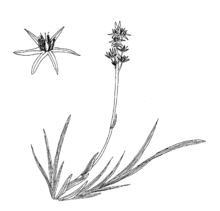Narthecium ossifragum
| Narthecium ossifragum | |
|---|---|
.jpg) | |
| Scientific classification | |
| Kingdom: | Plantae |
| (unranked): | Angiosperms |
| (unranked): | Monocots |
| Order: | Dioscoreales |
| Family: | Nartheciaceae |
| Genus: | Narthecium |
| Species: | N. ossifragum |
| Binomial name | |
| Narthecium ossifragum (L.) Huds. | |
Narthecium ossifragum, commonly known as bog-, Lancashire- or bastard asphodel, is a plant of Western Europe, found on wet, boggy moorlands up to about 1000 m in elevation. It produces spikes of bright yellow flowers in summer. The bright orange fruits have been used as a colourant to replace saffron by Shetland Islanders.[1] Despite the plant's English name, it is not particularly closely related to the true asphodels.
The Latin name means "weak bone", and refers to a traditional belief that eating the plant caused sheep to develop brittle bones. The probable origin of this story is that sheep eating a calcium-poor diet are likely to develop bone weakness, and N. ossifragum favours acidic, low calcium soils.[1]
The plant causes a disease of sheep called alveld, "elf fire", in Norway. Not all stands of the plant are toxic, and the toxicity may be the side effect of the plant's response to a fungal infection.[2][3][4]
It can be found in purple moor grass and rush pastures.
It is tufted, hairless perennial. The leaves are narrow.[5]
Gallery
-
.jpg)
Narthecium ossifragum in flower
-

N. ossifragum flower
-

N. ossifragum fruiting
-

N. ossifragum in fruit
-

N. ossifragum, in situ near El Serrat, Andorra
Illustrations
-

Narthecium ossifragum
Illustration in:
Jakob Sturm: "Deutschlands Flora in Abbildungen",
Stuttgart (1796) -

Narthecium ossifragum
Illustration in:
Jakob Sturm: "Deutschlands Flora in Abbildungen",
Stuttgart (1796)
clean version -

Narthecium ossifragum
Drawing by
Elly Waterman
| Wikimedia Commons has media related to Narthecium ossifragum. |
References
- ↑ 1.0 1.1 Richard Mabey Flora Britannica
- ↑ Handbook of Plant and Fungal Toxicants by J. P. Felix D'Mello
- ↑ George B. B. Mitchell, 'Non-parasitic skin diseases of sheep' In Pract., Vol. 10, Issue 2, 69-73, March 1, 1988
- ↑ Arne Flåøyen, 'Studies on the aetiology and pathology of alveld'
- ↑ Sterry, Paul (2006). Complete British wild flowers. London: Collins. ISBN 978-0-00-720469-4.